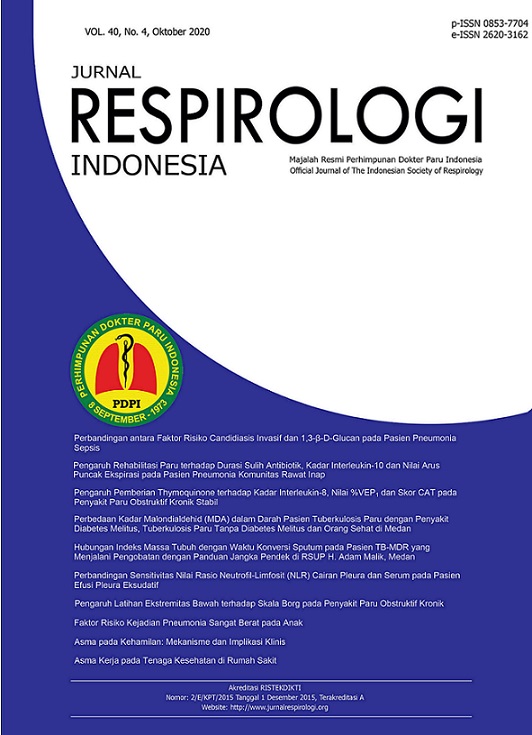The Correlation of Body Mass Index with Sputum Conversion Time in MDR-TB Patients Undergoing Treatment with Short Term Regimen at H. Adam Malik Medan General Hospital
DOI:
https://doi.org/10.36497/jri.v40i4.130Keywords:
MDR-TB, Short Term Regimen, Body Mass Index, Sputum Conversion TimeAbstract
Background: It was estimated about 10.4 million incidence of TB cases worldwide, of which 580,000 were MDR TB cases in 2015, however, only 125,000 were successfully found and treated. The World Health Organization (WHO) issued a recommendation of 9-11 month Short Term Regimen (STR) guideline that could provide satisfactory results in terms of successfull outcome, easier to control and also low-cost. The study aimed to analyze the correlation between Body Mass Index (BMI) and sputum conversion time in MDR TB patients undergoing treatment with STR and to determine the final treatment outcome using STR at H. Adam Malik Medan General Hospital, North Sumatra, Indonesia. Methods: This was a case series study of a total 76 MDR TB patients undergoing treatment using STR. Samples were obtained from medical record of the pulmonary isolation ward and MDR TB clinic at H. Adam Malik Medan General Hospital. Data were analyzed descriptively to identify the trend in sputum conversion from nine months of treatment. Results: The number of patients with normal BMI was 51.3% higher than those of low, very low and high BMI. The time to sputum conversion occured in the second month of treatment. All groups of BMI categories experienced conversions and normal BMI was higher in number. At the end of the treatment evaluation, the cure rate was 44.8%, the drop out was 28.9%, the regimen change was15.8%, died 9.2%, and moved 1.3%. Conclusion: There was a significant correlation between BMI and sputum conversion time in MDR TB patients. Good nutritional status was a predictor of treatment success.Downloads
References
World Health Organization. Short Term Regimen for Multi Drug Resistance TB. Geneva: WHO Press. 2017: 8-20.
Persatuan Dokter Paru Indonesia. Pedoman Diagnosis dan Penatalaksanaan Tuberkulosis di Indonesia. Jakarta; 2011:1-64.
Kementerian Kesehatan Republik Indonesia. Pengobatan Pasien TB Resistan Obat dengan Panduan Jangka Pendek. Jakarta; 2017:1-43.
Kurbatova EV, Gammino VM, Bayona J, Becerra MC, Danilovitz M, Falzon D, et al. Predictors of sputum culture conversion among patients treated for multidrug-resistant tuberculosis. Int J Tuberc Lung Dis. 2012;16(10):1335-43.
Bhargava A, Chatterjee M, Jain Y, Chatterjee B, Kataria A, Bhargava M, et al. Nutritional status of adult patients with pulmonary tuberculosis in rural central India and its association with mortality. PLoS One. 2013;8(10):e77979.
Cegielski JP, McMurray DN. The relationship between malnutrition and tuberculosis: evidence from studies in humans and experimental animals. Int J Tuberc Lung Dis. 2004;8(3):286-98.
Tierney DB, Franke MF, Becerra MC, et al. Time to culture conversion and regimen composition in multidrug-resistant tuberculosis treatment. PLoS One. 2014;9(9):e108035.
Nyaki FS, Taksdal M, Mbuya AW, Sariko M, Lekule IA, et al. Predictors of Nutritional Status in Patients Treated for Multidrug-Resistant Tuberculosis at a Referral Hospital in Tanzania. J Clin Infect Dis Pract. 2016;1:115.
Velayutham B, Nair D, Kannan T, Padmapriyadarsini C, Sachdeva KS, Bency J, et al. Factors associated with sputum culture conversion in multidrug-resistant pulmonary tuberculosis. Int J Tuberc Lung Dis. 2016;20(12):1671-76.
Putri FA, Burhan E, Nawas A, Soepandi PZ, Sutoyo DK, Agustin H, et al. Body mass index predictive of sputum culture conversion among MDR-TB patients in Indonesia. Int J Tuberc Lung Dis. 2014;18(5):564-70.
Kenangalem E, Waramori G, Pontororing GJ, Sandjaja, Tjitra E, Maguire G, et al. Tuberculosis Outcomes in Papua, Indonesia: The Relationship with Different Body Mass Index Characteristics between Papuan and Non-Papuan Ethnic Groups. PLoS ONE. 2013;8(9): e76077.
Hesseling AC, Walzl G, Enarson DA, Carroll NM, Duncan K, Lukey PT, et al. Baseline sputum time to detection predicts month two culture conversion and relapse in non-HIV-infected patients. Int J Tuberc Lung Dis. 2010;14(5):560-70.
Trauer JM, Achar J, Parpieva N, Khamraev A, Denholm JT, Falzon D, et al. Modelling the effect of short-course multidrug-resistant tuberculosis treatment in Karakalpakstan, Uzbekistan. BMC Med. 2016;14(1):187.
Todar, K. Todar's Online textbook of bacteriology. [internet]. 2006 [cited 2018 Oct 28]. Available from: http://www.textbookofbacteriology.net/.
Zuliana I. 2009. Pengaruh Karakteristik Individu, Faktor Pelayanan Kesehatan dan Faktor Pengawas Menelan Obat terhadap Tingkat Kepatuhan Penderita TB Paru dalam Pengobatan di Puskesmas Pekan Labuhan Kota Medan. Skripsi. FKM Universitas Sumatera Utara Medan.
Sagwa E, Mantel-Teeuwisse AK, Ruswa N, Musasa JP, Pal S, Dhliwayo P, et al. The burden of adverse events during treatment of drug-resistant tuberculosis in Namibia. South Med Rev. 2012;5(1):6-13.
Nunn AJ, Rusen ID, Van Deun A, Torrea G, Phillips PP, Chiang CY, et al. Evaluation of a standardized treatment regimen of anti-tuberculosis drugs for patients with multi-drug-resistant tuberculosis (STREAM): study protocol for a randomized controlled trial. Trials. 2014;15:353.
Moodley R, Godec TR; STREAM Trial Team. Short-course treatment for multidrug-resistant tuberculosis: the STREAM trials. Eur Respir Rev. 2016;25(139):29-35.
Jain K, Desai M, Solanki R, Dikshit RK. Treatment outcome of standardized regimen in patients with multidrug resistant tuberculosis. J Pharmacol Pharmacother. 2014;5(2):145-9.
Kendall EA, Fojo AT, Dowdy DW. Expected effects of adopting a 9 month regimen for multidrug-resistant tuberculosis: a population modelling analysis. Lancet Respir Med. 2017;5(3):191-9.
TB CARE I, UNAIDS (USA). International Standards for Tuberculosis Care. 3rd ed. San Fransisco: The Hague; 2014.
Briasoulis A, Agarwal V, Pierce WJ. QT prolongation and torsade de pointes induced by fluoroquinolones: infrequent side effects from commonly used medications. Cardiology. 2011;120(2):103-10.
Downloads
Published
Issue
Section
License
- The authors own the copyright of published articles. Nevertheless, Jurnal Respirologi Indonesia has the first-to-publish license for the publication material.
- Jurnal Respirologi Indonesia has the right to archive, change the format and republish published articles by presenting the authors’ names.
- Articles are published electronically for open access and online for educational, research, and archiving purposes. Jurnal Respirologi Indonesia is not responsible for any copyright issues that might emerge from using any article except for the previous three purposes.
















